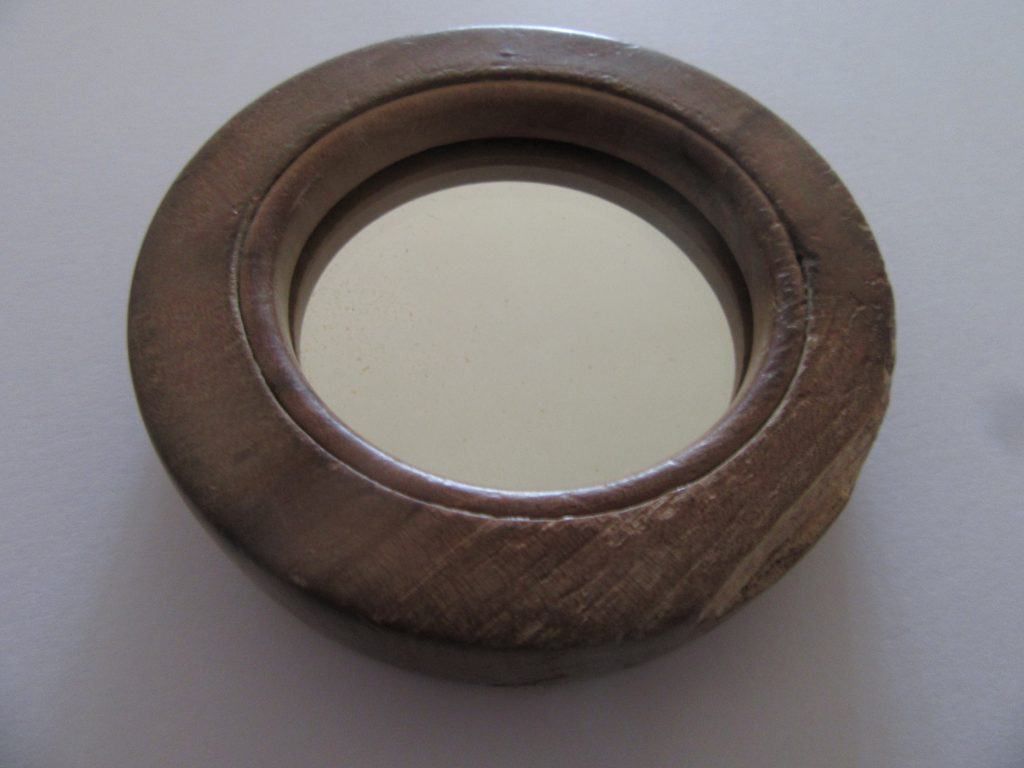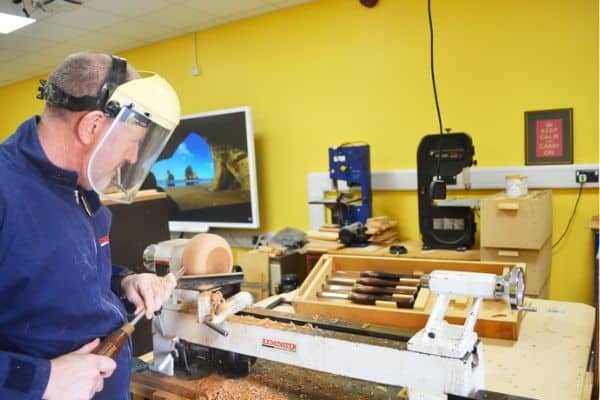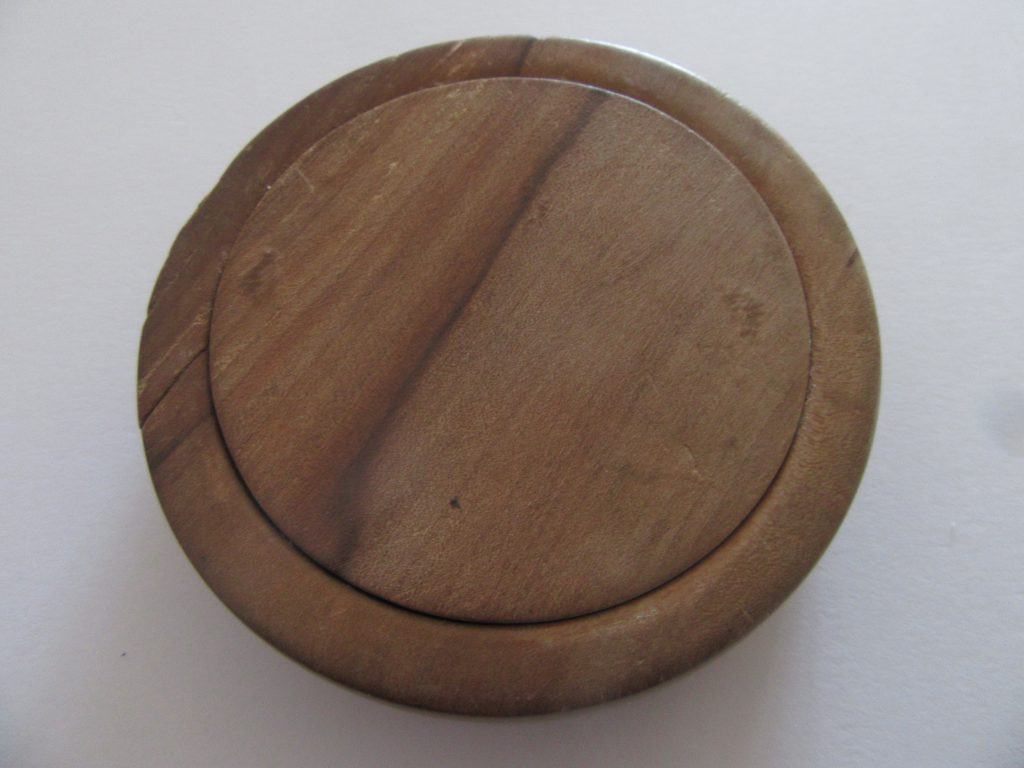A craftsman/educator’s life, in one object by Michael Henson, Woodwork Tutor at the Basildon Craft Studios
Anyone who has heard any of Neil MacGregor, curator of the British Museums fascinating Radio 4 series, The History of the World in 100 objects, will know that a single object can come to represent a whole epoch of human history. Recently that has become apparent in my own life as a craftsman/educator. It too could be represented by an artifact I made when I was at school, a small handbag mirror which, as every schoolboy, I turned for my Mum, out of pear.
As part of my O level woodwork I wanted to go through the whole process of taking a piece of timber from the vertical to the horizontal, to season, and then design and make an artefact from it. So, when builders began to clear the orchard at the bottom of the school-drive, I went with my woodwork teacher Mr Porter and removed the ancient apple and pear trees that grew there.
In class we converted the trunks into logs and we ‘put them in stick’ (a stack of green, or wet planks of wood with strips of wood between each plank), under the demountable classrooms that were two or three feet off the ground and perfect for air to circulate through the pile of planks in order to season (very slowly and gradually dry out so that shakes, which are cracks that emerge during the seasoning process if the wood is dried too quickly, to a minimum) them.
A minimum of a year later we removed those planks and so the process of designing an artifact to make from them began. What emerged from that process nearly 40 years ago now, is the very small, simple three component, circular handbag mirror, in the photograph, which sat on my Mum’s dressing table and never in her handbag.

This same handbag mirror would reappear again and again throughout my life as a craftsman/educator and though perhaps not quite like Del Boy’s Grandads broom having three different heads and four different handles but still being the same broom, it has experienced various abuses and repairs over the intervening 40 years.
The first time it reappeared was when I went to college to train as a teacher three or four years later. It was the early 80s, during the Thatcher recession and I was the youngest student on my course. All the others were middle aged men whose careers in industry had come to an abrupt end and who had the academic ability and inclination to change direction and retrain to become CDT, Craft Design and Technology teachers, the fashionable subject of that decade.
” It was the early 80s, during the Thatcher recession and I was the youngest student on my course.”
Home video technology was also just beginning and so as an introductory exercise all the students were recorded doing a two minute talk on a subject of their own choice. It was so we could see ourselves as others saw us, in the hope it might iron out some of the quirks in the way we presented ourselves.
All besuited, I took with me another piece of pear that had not been worked and spent two minutes trying to explain what made these same two pieces of wood from the same tree, fundamentally different from one another.
The recordings were then played back to the whole group for feedback. The results were shocking. For those of you who are old enough to remember I looked like a 19 year old Magnus Pyke stooped over, with arms flailing attempting to get my over message. I can still remember today some of the feedback, after they recovering from their hilarity. Terry the Marxist, who when asked, ‘How are you?’ Would always reply, “Fair to middlin, fair to middlin.” He had been blacklisted by every engineering works in the Midlands for his militant tendencies and as a result was the first to ‘go’ when the recession hit. As you might expect from such a political activist, he drew attention to the passion with which I had spoken about the subject, which he said more than made up for the somewhat odd presentation.

After carefully returning it to my Mum I didn’t consciously see the mirror again until 2009 when she was called home. Sadly, by then she didn’t remember her handbag mirror, Alzheimer’s having ravaged her incredibly acute mind. So, the handbag mirror in pear passed onto my wife and began to roll around in her handbag, more of which later, until last week.
40 years after it was made, in the middle of my 4th decade as a craftsman/teacher, in the curious circumstances of Covid 19, the handbag mirror in pear, came back to my mind. I was looking for something to stimulate discussion in the first Teams meeting with my woodturning students during the normal time of the class 19:30 – 21:30 on a Tuesday evening. A student had recently sent me some photos of a wooden surround he had been making in class and had completed while in isolation, for a magnifying glass. It belongs to his aging father who not only has a problem seeing things clearly without the glass, holding the glass is also very difficult for him now. So, Steve had turned a segmented surround for the magnifying glass with a handle just like a dressing table mirror. So, I asked my wife if I could borrow her handbag mirror to show the students as the turning method was very similar to Steve’s Dad’s magnifying glass surround.
However, I discovered that after 40 years pva glue looses its stick and had to get the glue gun out as we do today inorder to refix the back into its rebate.

That done on that evening I told the students something of the history of the handbag mirror and of course I went back to my first teaching experience on video all those years ago. I repeated what I had said then about the difference between the handbag mirror in pear and a raw piece of pear. The significance of taking a growing tree, felling it, seasoning the wood, and then designing and making an artifact from it. I spoke to them about the created beauty of the timber that had been revealed, the glorious red streaks running through the pale surrounding timber, still visible today, but which no human eye had ever seen before. I spoke about the stimulus for the design in my own personal observations and insights, not a great deal at 14 though. I mentioned the design discussions with my woodwork teacher and the technical advice and expertise from Mr Voller, the technician, especially when a simple two component artifact suddenly required a third because I made the opening in the ring for the mirror too large and so the only piece of mirror we had, fell through. So, I had to make the, most tiny of rings imaginable, to go around the inside of the main ring to prevent that happening. Something which would have been impossible had I been working with a timber like ash or oak.
I talked about the time that had been invested in it from the moment the tree was felled to the completion of the handbag mirror and finally about that unquantifiable ‘something, that every artist and craftsperson puts into everything they ever they make, ‘themselves’.
“The students listened as attentively as they had done 35 years before and I hope they felt my passion for wood, for woodwork and for the process of passing that passion on, known as teaching.”
I had said all that decades before, when I first used it as an object lesson, but this time I also had to speak of the years of use, especially in later times rolling around in the bottom of a handbag. All this had inevitably led to the erosion of the soft sapwood and spring and summer growth rings that once adorned the leading edge of the mirror literally leaving grooves where once solid wood had been.
So once again last Tuesday, the students listened as attentively as they had done 35 years before and I hope they also felt what Terry the Marxist felt, my passion for wood, for woodwork and for the process of passing that passion on, known as teaching.
40 years, a craftsman/educator’s life, so far, in one object.
Our woodturning courses are returning to centres. By the end of the course you will:
- Know how to select, source and calculate the cost of appropriate materials and equipment for woodturning
- Use tools and equipment safely and confidently. Plan and produce a basic project to make at least one craft item
- Explore sources of inspiration for your work and current trends.





